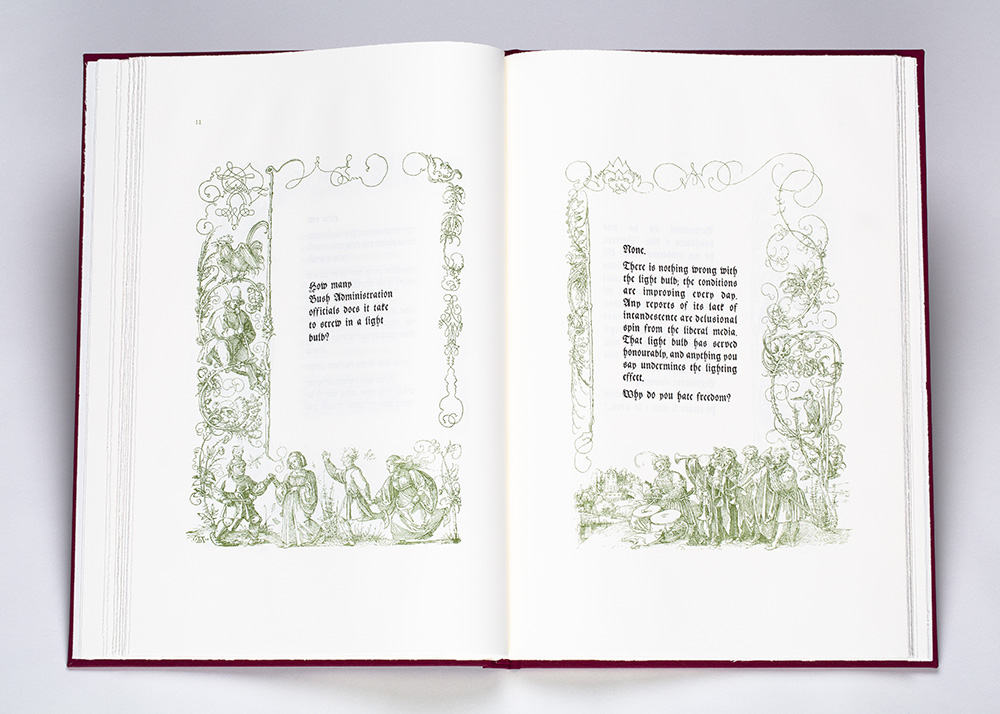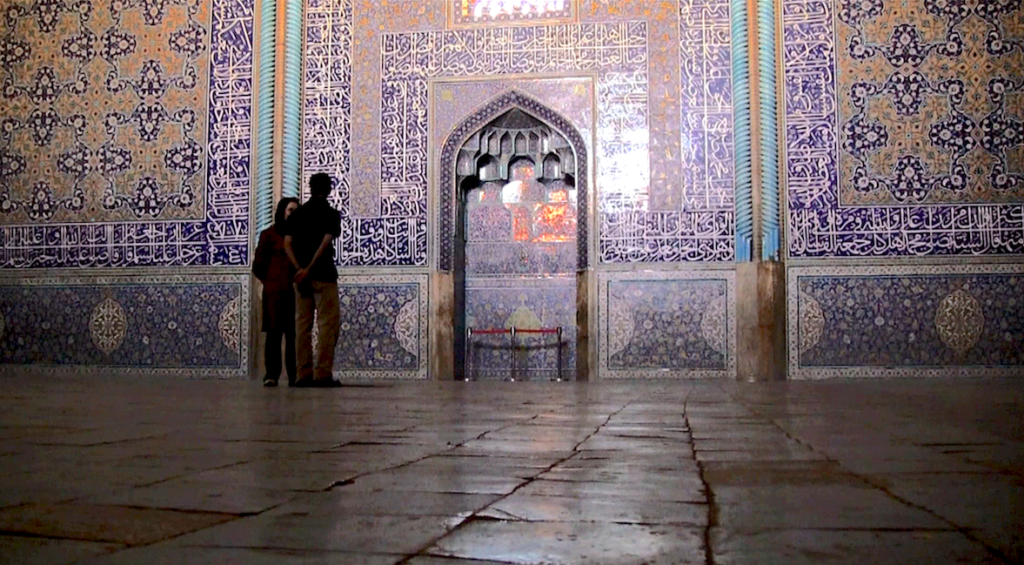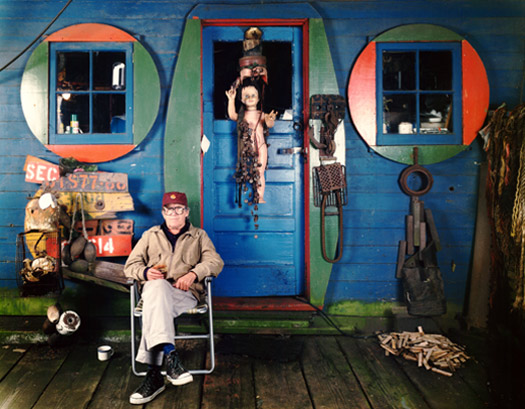
The Book of Jests began in an antiquarian bookstore in Vienna where Hyung-Min Yoon found and purchased a 1922 edition of Albrecht Dürer’s illustrations. The book, Marginal Drawings for the Prayer of Emperor Maximilian I, was bound in grey cloth with beveled edges, and contained illustrations created for the margins of a prayer book. Originally created in 1515, Dürer’s illustrations were used in the mass publication and distribution of a single Christian prayer to multiple language groups, leaving blank the centre of the page, onto which the texts of different languages could be printed. For an artist whose work has explored the ‘imperfect path’ of translation, the interpretation of images across cultural contexts, and the history of printed text, this central unmarked ground must have seemed an almost overwhelming space of possibility.
The illustrations, inked in green and orange and sepia, are familiar biblical themes – mass produced extensions of the sacred manuscripts illuminated by hand in Medieval times. Horned devils perched on filigree, winged dragons and architectural flourishes, charging mounted knights and mythological beasts: what might these have meant to the readers of some forty-three languages of the polyglot prayer book? What universalities were assumed to reside in the scrollwork embellishments, allegorical arrangements and fantastical landscapes? What process of translation transformed the meaning of these renderings placed next to such diverse scripts?
Vilém Flusser’s The Gesture of Writing is a typed work from 1991. It describes in fine, methodical detail the act of writing through its phenomenology. Written in English, it is an example of his practice of translating and retranslating his writing as a way of mining his own thought: seven versions were produced in four languages. He begins by analyzing handwriting:
“It is a gesture of making holes, of digging, of perforating. A penetrating gesture. To write is to in-scribe, to penetrate a surface, and a written text is an inscription, although as a matter of fact it is in the vast majority of cases an onscription. Therefore to write is not to form, but to in-form, and a text is not a formation, but an in-formation. I believe that we have to start from this fact if we want to understand the gesture of writing: it is a penetrating gesture that informs a surface.”
Flusser traces the movement from writing by hand as a sculptural form, forward to typing, a process that removes irregularities and unwanted incidental marks, in which “we no longer engrave with a stick, but with a series of hammers”. Placing the gesture of writing into an historical context, he notes that the practice of typing ultimately transformed how we define writing, that is, as a conceptual gesture processed through a rigidly formed technology, a template.
The Gesture of Writing contains strikeovers and typos, and moments when the hammers glanced unevenly. Reading it (so odd in PDF form!) thus also requires care and a certain level of translation, of filling in, or working to discern the author’s intent. The text lightly abrades our reading of it, a distant echo of Flusser’s process of translating and re-translating. But his process, while arduous, was not endless:
“Theoretically I could go on translating the re-translating ‘ad nauseam’ or to my exhaustion. But practically I find that the chain of thoughts is exhausted in the process long before I myself am exhausted. Thus the process of translation and re-translation provides a criterion for the wealth of the thought to be written: the sooner the process exhausts the thought (the sooner it falls into repetition), the less worthy the thought is of being written.”
Dürer’s lithographs, inscribed and re-inscribed over centuries, are now subject to a new interpretive maneuver, moving from their 14th century European Christian context to the present day. What sort of profane texts might occupy the space intended for the sacred?
The artist looks to the role of the Jester, an ancient figure found the world over, and found in close proximity to power. Able to speak the unspeakable, the Jester claims an uneasy space of intimacy and exclusion, whether in a monarch’s court or, these days, on late night television. The Jester draws and re-draws the line between insult and adulation, using flourishes, oblique angles and sidelong curves in his speech. Jokes – like prayers – are most often spoken.

Transposing the method of the polyglot prayer book, Yoon sought out political jokes in English, Italian, Hebrew, Hindi, Spanish, Korean, Mandarin, Russian, Japanese, Arabic, German, Greek and Czech from friends and associates. They address classic themes such as hypocrisy, corruption and oppressive bureaucracy yet riff on the culturally specific paradoxes and absurdities of power. Certain formats – light bulb jokes, doctor jokes, and the like – repeat across nations, historical moments and regimes. Using a font developed in Dürer’s times, Yoon letter-pressed these jokes into the Terra nullius at the centre of the illuminated pages. By indexing the landscapes, forms and figures of the illustrations to the content of the jokes, new meanings are constructed. Emil Hácha, the President of Czechoslovakia during Nazi occupation, becomes a hooded monk waiting for dinner; German Chancellor Angela Merkel is seen as the Virgin Mary, no less, and Berlisconi becomes King David. Bound in deep magenta, the photo-lithographs with their letterpress texts form a new volume of flagrant iconoclasms – and in the case of the Arabic scripts, near-blasphemies. Yoon’s method proposes the artist as editor, as publisher of a trans-historical, multilingual anthology, in a finely crafted limited edition.
In the gallery, in addition to the book, framed prints reproduce several two-page spreads. These particular excerpts are often in a left-page question, right-page answer format, or one printed page weights the blankness of its neighbour. In the archive area behind the exhibition space, a video records the artists’ hands turning the pages of the book. She takes care to time the page-turning correctly: in comedy timing is everything. This video of the silent reading, along with Yoon’s process of photographing and photographing the pages, as well as the framing and reframing of the letterpress jokes remind us of Flusser, translating and translating again. From one medium to another and back again, Yoon re-works her thinking along Flusser’s chain, to the point when all possible meanings have been extracted, seeking exhaustion.
Lorna Brown
August, 2014
DOWNLOAD| The Book of Jests, an essay by Lorna Brown.



